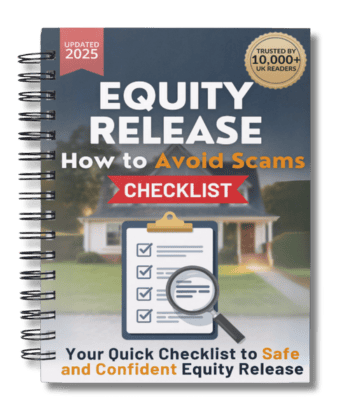
4 Types of Lifetime Mortgage You Should Know About in 2025
 Be aware. Equity release comes with drawbacks which are important to think about. Lifetime mortgages are secured loans. Compound interest means the amount you owe can grow quickly. Equity release reduces your estate's value and may impact means-tested benefits.
Be aware. Equity release comes with drawbacks which are important to think about. Lifetime mortgages are secured loans. Compound interest means the amount you owe can grow quickly. Equity release reduces your estate's value and may impact means-tested benefits.Key Takeaways...
- Lifetime mortgages allow UK homeowners aged 55+ to unlock tax-free cash from their property without needing to move or make monthly repayments, helping to fund retirement, clear debts, or support family.
- There are four main types: lump sum, drawdown, interest-only, and enhanced, each tailored to specific financial goals, from flexible borrowing to minimising interest or maximising loan size for those with health issues.
- In 2022, the average equity release loan was £133,2161, enough to support a single pensioner for up to 12 years of modest living, highlighting how lifetime mortgages can significantly boost retirement income.
In 2022, UK homeowners released an average of £133,216 through equity release. That amount could support a single pensioner for up to 12 years of modest living or 5 years of comfortable retirement. For many, a lifetime mortgage provides a practical way to access home equity without selling or downsizing.
With choices like lump sum, drawdown, interest-only, and enhanced plans, understanding which type suits your needs can be challenging.
In This Article, You Will Discover:
This guide explains the key features of each lifetime mortgage type, helping you make a clear and informed decision based on your financial goals.
How Does a Lifetime Mortgage Work? Lifetime Mortgages Over 60s
A lifetime mortgage is a long-term loan secured against your home, designed for UK homeowners aged 55 and over. It allows you to release tax-free cash from your property while retaining full ownership and the right to live in your home for the rest of your life.
There are no required monthly repayments. Instead, interest accumulates over time, and the loan, along with any rolled-up interest, is repaid when you pass away or move into long-term care, usually through the sale of the property.
Many modern lifetime mortgages now include optional repayment features, giving you the flexibility to:
- Pay all or part of the interest regularly
- Reduce the final loan balance
- Preserve more of your estate for inheritance

Key Features of a Lifetime Mortgage
| Feature | Details |
|---|---|
| Minimum Age | 55 (some lenders may require 60+) |
| Property Ownership | You retain full legal ownership |
| Repayments | Optional, interest rolls up unless you choose to repay |
| Loan Repayment | Repaid from sale of home after death or long-term care move |
| Flexibility | Many plans allow voluntary payments without penalty |
| Interest Type | Typically fixed for life, with compounding if not repaid |
| Tax-Free Cash | Funds released are not subject to income tax |
| Inheritance Protection | Some plans offer features to protect a portion of your property value |
How Much Can You Borrow?
The amount you can release depends on several factors:
- Your age: Older borrowers can access a higher percentage of their home’s value
- Your property's value: Typically must be worth at least £70,000
- Lender criteria: Varies by provider, with some restrictions on property type
- Health and lifestyle: Enhanced plans may allow you to borrow more if you have qualifying conditions like high blood pressure or a history of smoking
Typical Loan-to-Value (LTV) Ranges:
| Age | Approximate LTV Available |
|---|---|
| 55 | 20%–25% |
| 65 | 30%–40% |
| 75+ | 45%–50%+ |
Lifetime Mortgage vs Equity Release
A lifetime mortgage is the most popular form of equity release, but it is not the only one. The other main option is a home reversion plan.
Key Differences:
| Feature | Lifetime Mortgage | Home Reversion Plan |
|---|---|---|
| Ownership | You retain ownership | You sell part or all of your home |
| Repayments | None required (unless you choose to pay interest) | None |
| Cash Received | Based on a loan-to-value percentage | Based on property share sold |
| Inheritance Impact | Interest rolls up, reducing estate value | You give up a portion of home value |
| Common in UK? | Yes (majority of equity release products) | Less common |
What Is a Whole Life Mortgage?
A whole life mortgage is another long-term financial product designed to last your lifetime. Unlike a lifetime mortgage, a whole life mortgage:
- Requires regular monthly repayments
- Works similarly to a traditional mortgage but with no fixed term
- May be suitable for those wanting to manage their debt proactively
- Can help reduce compound interest by maintaining steady repayments
Whole life mortgages are less common and typically better suited to homeowners with a steady retirement income who prefer not to accrue rolled-up interest.
Additional Considerations for Over 60s
If you’re over 60 and considering a lifetime mortgage, keep in mind:
- Eligibility depends not just on age but also on property value, condition, and location
- Most lenders require properties to be in the UK and free of significant structural issues
- Flats, leasehold properties, and retirement homes may face additional restrictions
- Lifetime mortgages from lenders approved by the Equity Release Council come with a no-negative-equity guarantee, ensuring you never owe more than the home’s eventual sale value
What Are the Different Types of Lifetime Mortgages, and Which Is Right for You?
Lifetime mortgages in the UK are available in several formats, each offering unique features suited to different financial needs and retirement goals.
The main types are:
- Lump Sum Lifetime Mortgages
- Drawdown Lifetime Mortgages
- Interest-Only Lifetime Mortgages
- Enhanced Lifetime Mortgages
Choosing the right option depends on how you plan to use the funds, your approach to managing interest, and whether any health or lifestyle factors apply.
Lump Sum Lifetime Mortgage
A lump sum lifetime mortgage provides a one-time, upfront payment. It's ideal for those who need a significant amount of money immediately, such as for home improvements, debt repayment, or helping family members financially.
Key Features:
- A single cash release, typically larger than initial drawdown amounts
- Interest starts accruing on the full amount from day one
- No further borrowing permitted after the initial release
Market Insight: In Q2 2023, 48% of new lifetime mortgage clients chose a lump sum plan, down from 55% in the same quarter of 20222. This decline reflects a growing preference for more flexible products like drawdown plans.
Drawdown Lifetime Mortgage
A drawdown lifetime mortgage offers an initial release of funds, with the option to withdraw more money in the future from a pre-agreed reserve facility. Interest is only charged on the amount withdrawn, making it a more cost-effective solution over time.
Key Benefits:
- Greater flexibility in how and when you access your funds
- Interest only accrues on money actually drawn
- Useful for managing retirement income in stages
Recent Trends: According to the Equity Release Council, in Q2 2025, drawdown customers took larger upfront amounts but kept smaller sums in reserve compared to the previous year3, suggesting a strategic shift in how homeowners manage their equity release over time.
Interest-Only Lifetime Mortgage
With an interest-only lifetime mortgage, you make monthly interest payments to prevent the loan from growing over time. This option is suited to borrowers who want to control the size of their loan and preserve more of their estate for beneficiaries.
Advantages:
- Keeps the loan balance static (no interest roll-up)
- Monthly repayments can be paused or adjusted with lender agreement
- Suitable for those with reliable retirement income
Interest-only plans are often chosen by borrowers who want to reduce long-term borrowing costs while maintaining flexibility.
Enhanced Lifetime Mortgage
An enhanced lifetime mortgage allows you to borrow more than standard plans or access lower interest rates if you meet specific health or lifestyle criteria. These include conditions such as high blood pressure, diabetes, heart disease, or lifestyle factors like smoking or a high BMI.
Eligibility Factors:
- Certain diagnosed health conditions
- Lifestyle habits (e.g. smoking, alcohol use)
- Prescription medication for chronic illness
- Combined effect of age and health status
Benefits:
- Higher maximum loan-to-value (LTV)
- Potential access to lower interest rates
- No restriction on staying in your home for life
Enhanced lifetime mortgages are ideal for those looking to maximise borrowing due to health or lifestyle circumstances, especially when facing increased costs in retirement.
Lifetime Mortgage Type Comparison
| Feature | Lump Sum | Drawdown | Interest-Only | Enhanced |
|---|---|---|---|---|
| Initial Access | One-time lump sum | Initial + flexible reserve | Fixed draw with monthly interest payments | One-time or staged (varies by lender) |
| Interest Accrual | On full amount | Only on withdrawn funds | None if interest paid monthly | On withdrawn or full amount |
| Repayments Required | No | No | Yes (interest only) | No (unless optional payments chosen) |
| Further Withdrawals | Not available | Yes, as needed | Not typical | Varies by product |
| Best For | Large, one-off needs | Ongoing or staged income | Inheritance preservation | Maximising borrowing based on health |
Is a Lifetime Mortgage the Right Option for You?
Deciding whether to take out a lifetime mortgage depends on your financial goals, your long-term plans for your home, and your family situation. These products can be a useful way to access tax-free cash in retirement, but they also come with long-term implications.
A lifetime mortgage might be suitable if:
- You want to unlock equity without moving home
- You don’t need to leave the full property value as an inheritance
- You prefer not to make monthly repayments
- You have a clear plan for how the funds will be used
However, it may not be the best option if:
- You want to preserve as much inheritance as possible
- You are eligible for other sources of retirement income
- You are unsure about staying in your current home long-term
Always speak with a regulated equity release advisor before proceeding. They can assess your circumstances and compare alternatives such as downsizing, retirement interest-only mortgages, or other financial planning tools.
Alternatives to Lifetime Mortgages
A lifetime mortgage is not the only way to unlock value from your home in later life. Depending on your financial situation and long-term goals, you may want to consider one of the following alternatives:
- Downsizing
Selling your current home and buying a smaller, less expensive property can release equity without taking on any debt. This option may also reduce your living costs, but it involves moving, which isn’t suitable for everyone. - Retirement Interest-Only (RIO) Mortgages
RIO mortgages require monthly interest payments but allow you to keep the balance static until you die or move into care. They are assessed based on affordability and are best for borrowers with a stable retirement income. - Remortgaging or Traditional Equity Release
If you’re under 55 or only need funds for a short period, a standard remortgage or other loan product may be more suitable than lifetime equity release. - State Benefits or Budgeting Advice
Before taking out any form of loan, it’s worth checking whether you are eligible for government support or seeking help from a financial advisor to manage existing income and assets more effectively.
Each of these options has its own pros and cons. A professional equity release advisor can help compare them side-by-side with a lifetime mortgage to ensure you choose the right path for your circumstances.
How to Apply for a Lifetime Mortgage
Applying for a lifetime mortgage involves several steps, all designed to ensure you fully understand the product and that it suits your needs:
1. Speak With a Qualified Equity Release Advisor
You are required by law to get advice from a regulated financial adviser who specialises in equity release. They will assess your financial situation, explain your options, and recommend a suitable product.
2. Property Valuation and Application
Once you decide to proceed, your home will be professionally valued. The lender will then review your application based on your age, property value, and (if applicable) health and lifestyle factors.
3. Receive an Offer
If approved, you’ll receive a lifetime mortgage offer outlining the terms, interest rate, and any special conditions. Your adviser will go through these with you to ensure everything is clear.
4. Legal Advice and Completion
A solicitor will handle the legal side of the process, representing your interests and confirming your understanding of the mortgage terms. Once all paperwork is complete, the funds will be released to you.
The entire process typically takes 4 to 8 weeks from start to finish. Throughout, your adviser and solicitor will guide you to ensure you’re making an informed decision with full transparency.

Frequently Asked Questions
Yes, it may be possible to switch from one type of lifetime mortgage to another, depending on your lender’s policies and the terms of your original agreement.
Some providers allow you to transfer to a more suitable product, such as moving from a lump sum to a drawdown plan or switching to an enhanced plan if your health circumstances change.
However, switching may involve early repayment charges or additional fees, so it is essential to speak with your lender or a qualified equity release advisor before making any changes.
Yes, it may be possible to switch from one type of lifetime mortgage to another, depending on your lender’s policies and the terms of your original agreement.
Some providers allow you to transfer to a more suitable product, such as moving from a lump sum to a drawdown plan or switching to an enhanced plan if your health circumstances change.
However, switching may involve early repayment charges or additional fees, so it is essential to speak with your lender or a qualified equity release advisor before making any changes.
Yes, you can take out a lifetime mortgage if you still have an existing mortgage on your property, but the lifetime mortgage must be used to pay off the outstanding balance.
Any remaining funds from the equity release can then be used for other purposes.
This can be a useful solution for homeowners who want to eliminate monthly mortgage payments and improve their cash flow in retirement.
Yes, you can take out a lifetime mortgage if you still have an existing mortgage on your property, but the lifetime mortgage must be used to pay off the outstanding balance.
Any remaining funds from the equity release can then be used for other purposes.
This can be a useful solution for homeowners who want to eliminate monthly mortgage payments and improve their cash flow in retirement.
Lump sum mortgages offer a large, one-time payment, ideal for big expenses, but interest accrues on the full amount immediately, which can reduce your estate.
Drawdown mortgages let you access funds gradually, so you pay interest only on what you use. However, future withdrawals depend on lender terms and may not be guaranteed.
Interest-only mortgages help maintain your equity by avoiding rolled-up interest, but you must afford regular payments, which may become difficult later in retirement.
Enhanced mortgages offer better terms if you have certain health conditions, but eligibility is limited, and borrowing more upfront can increase long-term costs.
Each type involves trade-offs between flexibility, cost, and impact on inheritance. Speak to a qualified advisor to assess what suits your situation best.
The right lifetime mortgage for you will depend on your personal circumstances, financial goals, health status, and how you plan to use the funds.
If you need a large amount upfront, a lump sum mortgage might be suitable.
If you prefer flexibility and want to limit interest, a drawdown plan could be more appropriate.
Interest-only plans work well for those with sufficient income to manage payments, while enhanced mortgages may offer better terms if you have certain medical conditions.
A qualified equity release advisor can help assess your situation and recommend the most appropriate product.
Yes, you remain the full legal owner of your home when you take out a lifetime mortgage. The loan is secured against your property, but you retain the right to live there for the rest of your life or until you move into long-term care, as long as the terms of the agreement are met.
Yes, a lifetime mortgage reduces the value of your estate because the loan, along with any rolled-up interest, is repaid from the eventual sale of your home. This can leave less for your beneficiaries.
However, some plans offer inheritance protection to ring-fence a portion of your property’s value for loved ones.
In many cases, yes. Most lifetime mortgages approved by the Equity Release Council are portable, meaning you can transfer the loan to a new eligible property.
The new property must meet your lender’s criteria, and additional legal or valuation fees may apply.
Lifetime mortgages are regulated by the Financial Conduct Authority (FCA), and products from Equity Release Council members come with safeguards like the no-negative-equity guarantee.
This ensures you will never owe more than the value of your home when it is sold, providing protection for both you and your heirs.
Common costs include advice fees, solicitor’s fees, and valuation charges. Some of these may be waived or included in the product, depending on the lender.
While there are no monthly repayments required unless you choose an interest-only option, interest does accumulate over time and can significantly increase the total repayment amount.
Yes, many homeowners use funds from a lifetime mortgage to give early financial support to their children or grandchildren, often for help with a house deposit, education, or debt repayment.
This is sometimes called “living inheritance” and can be a valuable part of intergenerational planning.
Conclusion: Key Insights on Lifetime Mortgages
Lifetime mortgages offer a flexible way for homeowners aged 55 and over to unlock the value of their property without selling or downsizing. Whether you need a large one-off sum, flexible withdrawals over time, or a plan tailored to specific health conditions, there is a lifetime mortgage to suit a wide range of retirement strategies.
With products ranging from lump sum and drawdown to interest-only and enhanced options, it's possible to match your mortgage choice to your financial goals, income preferences, and long-term plans.
Before proceeding, it is essential to seek independent advice from a qualified equity release advisor or broker. A professional can help you compare plans, assess eligibility, and understand the long-term implications for your estate and inheritance planning.
Choosing the right type of lifetime mortgage can help you make the most of your home’s value, maintain control over your financial future, and enjoy a more comfortable retirement.

Found an Error? Please report it here.





 100% private. No pressure. Just friendly guidance.
100% private. No pressure. Just friendly guidance.


